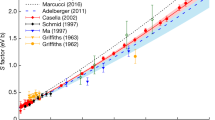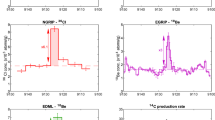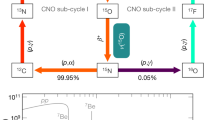Abstract
The Earth has cooled since its formation, yet the decay of radiogenic isotopes, and in particular uranium, thorium and potassium, in the planet’s interior provides a continuing heat source. The current total heat flux from the Earth to space is 44.2±1.0 TW, but the relative contributions from residual primordial heat and radiogenic decay remain uncertain. However, radiogenic decay can be estimated from the flux of geoneutrinos, electrically neutral particles that are emitted during radioactive decay and can pass through the Earth virtually unaffected. Here we combine precise measurements of the geoneutrino flux from the Kamioka Liquid-Scintillator Antineutrino Detector, Japan, with existing measurements from the Borexino detector, Italy. We find that decay of uranium-238 and thorium-232 together contribute  TW to Earth’s heat flux. The neutrinos emitted from the decay of potassium-40 are below the limits of detection in our experiments, but are known to contribute 4 TW. Taken together, our observations indicate that heat from radioactive decay contributes about half of Earth’s total heat flux. We therefore conclude that Earth’s primordial heat supply has not yet been exhausted.
TW to Earth’s heat flux. The neutrinos emitted from the decay of potassium-40 are below the limits of detection in our experiments, but are known to contribute 4 TW. Taken together, our observations indicate that heat from radioactive decay contributes about half of Earth’s total heat flux. We therefore conclude that Earth’s primordial heat supply has not yet been exhausted.
This is a preview of subscription content, access via your institution
Access options
Subscribe to this journal
Receive 12 print issues and online access
$259.00 per year
only $21.58 per issue
Buy this article
- Purchase on Springer Link
- Instant access to full article PDF
Prices may be subject to local taxes which are calculated during checkout




Similar content being viewed by others
References
Araki, T. et al. Experimental investigation of geologically produced antineutrinos with KamLAND. Nature 436, 499–503 (2005).
Abe, S. et al. Precision measurement of neutrino oscillation parameters with KamLAND. Phys. Rev. Lett. 100, 221803 (2008).
Bellini, G. et al. Observation of geo-neutrinos. Phys. Lett. B 687, 299–304 (2010).
Enomoto, S., Ohtani, E., Inoue, K. & Suzuki, A. Neutrino geophysics with KamLAND and future prospects. Earth Planet. Sci. Lett. 258, 147–159 (2007).
McDonough, W. F. & Sun, S-s. The composition of the Earth. Chem. Geol. 120, 223–253 (1995).
Arevalo, R. Jr, McDonough, W. F. & Luong, M. The K/U ratio of the silicate Earth: Insights into mantle composition, structure and thermal evolution. Earth Planet. Sci. Lett. 278, 361–369 (2009).
Pollack, H. N., Hurter, S. J. & Johnson, J. R. Heat flow from the Earth’s interior: Analysis of the global data set. Rev. Geophys. 31, 267–280 (1993).
Fiorentini, G., Lissia, M. & Mantovani, F. Geo-neutrinos and earth’s interior. Phys. Rep. 453, 117–172 (2007).
Fogli, G. L., Lisi, E., Palazzo, A. & Rotunno, A. M. Geo-neutrinos: A systematic approach to uncertainties and correlations. Earth Moon Planets 99, 111–130 (2006).
Giunti, C. & Kim, C. W. Fundamentals of Neutrino Physics and Astrophysics (Oxford Univ. Press, 2007).
Abe, S. et al. Production of radioactive isotopes through cosmic muon spallation in KamLAND. Phys. Rev. C 81, 025807 (2010).
Vogel, P. & Beacom, J. F. Angular distribution of neutron inverse beta decay, . Phys. Rev. D 60, 053003 (1999).
Schreckenbach, K., Colvin, G., Gelletly, W. & Von Feilitzsch, F. Determination of the antineutrino spectrum from 235U thermal neutron fission products up to 9.5 MeV. Phys. Lett. B 160, 325–330 (1985).
Hahn, A. A. et al. Antineutrino spectra from 241Pu and 239Pu thermal neutron fission products. Phys. Lett. B 218, 365–368 (1989).
Vogel, P. Reactor antineutrino spectra and their application to antineutrino-induced reactions. II. Phys. Rev. C 24, 1543–1553 (1981).
Achkar, B. et al. Comparison of anti-neutrino reactor spectrum models with the Bugey 3 measurements. Phys. Lett. B 374, 243–248 (1996).
Kopeikin, V. I., Mikaelyan, L. A. & Sinev, V. V. Inverse beta decay in a nonequilibrium antineutrino flux from a nuclear reactor. Phys. Atomic Nucl. 64, 849–854 (2001).
Bahcall, J. N., Serenelli, A. M. & Basu, S. New solar opacities, abundances, helioseismology, and neutrino fluxes. Astrophys. J. 621, 85–88 (2005).
Aharmim, B. et al. Low-energy-threshold analysis of the Phase I and Phase II data sets of the Sudbury Neutrino Observatory. Phys. Rev. C 81, 055504 (2010).
Herndon, J. M. Nuclear georeactor origin of oceanic basalt 3He/4He, evidence, and implications. Proc. Natl Acad. Sci. USA 100, 3047–3050 (2003).
Herndon, J. M. & Edgerley, D. A. Background for terrestrial antineutrino investigations: Radionuclide distribution, georeactor fission events, and boundary conditions on fission power production. Preprint at http://arxiv.org/abs/hep-ph/0501216v4 (2005).
Korenaga, J. Urey ratio and the structure and evolution of Earth’s mantle. Rev. Geophys. 46, RG2007 (2008).
Lyubetskaya, T. & Korenaga, J. Chemical composition of Earth’s primitive mantle and its variance: 2. Implications for global geodynamics. J. Geophys. Res. 112, B03212 (2007).
Enomoto, S. Experimental study of geoneutrinos with KamLAND. Earth Moon Planets 99, 131–146 (2006).
Rudnick, R. L., Gao, S., Holland, H. D. & Turekian, K. K. Treatise on Geochemistry: Composition of the Continental Crust, Vol. 3 1–64 (Pergamon, 2003).
Jaupart, C., Labrosse, S., Mareschal, J. C. & Schubert, G. Treatise on Geophysics: Temperatures, Heat and Energy in the Mantle of the Earth Vol. 7 253–303 (Elsevier, 2007).
Berger, B. E. et al. The KamLAND full-volume calibration system. J. Instrum. 4, P04017 (2009).
Acknowledgements
We thank E. Ohtani and W. F. McDonough for advice and guidance. The KamLAND experiment is supported by a Grant-in-Aid for Specially Promoted Research under grant 16002002 of the Japanese Ministry of Education, Culture, Sports, Science and Technology; the World Premier International Research Center Initiative (WPI Initiative), MEXT, Japan; and the US Department of Energy (DOE) grants DEFG03-00ER41138 and DE-AC02-05CH11231, as well as other DOE grants to individual institutions. The reactor data are provided by courtesy of the following electric associations in Japan: Hokkaido, Tohoku, Tokyo, Hokuriku, Chubu, Kansai, Chugoku, Shikoku and Kyushu Electric Power Companies, Japan Atomic Power Company and Japan Atomic Energy Agency. The Kamioka Mining and Smelting Company has provided service for activities in the mine.
Author information
Authors and Affiliations
Consortia
Contributions
All authors contributed equally to the work presented in this study.
Corresponding author
Ethics declarations
Competing interests
The author declare no competing financial interests.
Supplementary information
Supplementary Information
Supplementary Information (PDF 178 kb)
Rights and permissions
About this article
Cite this article
The KamLAND Collaboration. Partial radiogenic heat model for Earth revealed by geoneutrino measurements. Nature Geosci 4, 647–651 (2011). https://doi.org/10.1038/ngeo1205
Received:
Accepted:
Published:
Issue Date:
DOI: https://doi.org/10.1038/ngeo1205
This article is cited by
-
Analytical study of integrating downhole thermoelectric power generation with a coaxial borehole heat exchanger in geothermal wells
Scientific Reports (2024)
-
Geoneutrinos and geoscience: an intriguing joint-venture
La Rivista del Nuovo Cimento (2022)
-
DUNE atmospheric neutrinos: Earth tomography
Journal of High Energy Physics (2022)
-
Ariel – a window to the origin of life on early earth?
Experimental Astronomy (2022)
-
Life-cycle impact assessment methods for physical energy scarcity: considerations and suggestions
The International Journal of Life Cycle Assessment (2021)



